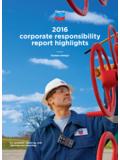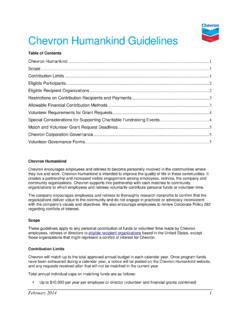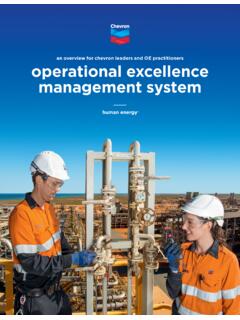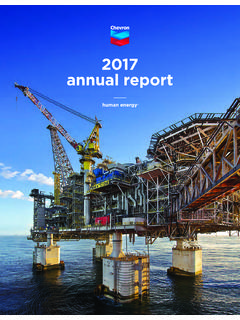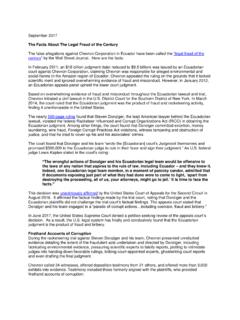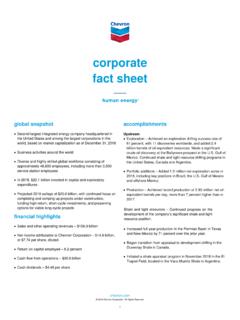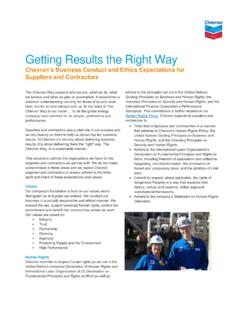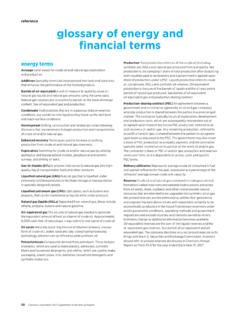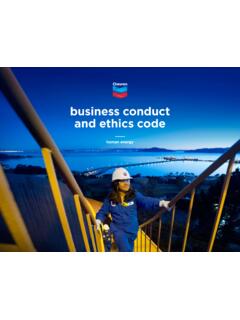Transcription of Diesel Fuels Technical Review - Chevron.com
1 >cfYXc DXib\k`e^. Diesel Fuels Technical Review chevron Products Company Diesel Fuels Technical Review chevron Products Company 6001 Bollinger Canyon Road San Ramon, CA 94583. chevron Products Company is a division of a wholly owned subsidiary of chevron Corporation. 2007 chevron Corporation. All rights reserved. chevron is a trademark of chevron Corporation. Recycled/Recyclable Recycled/recyclable paper paper 10M CBRES IDC 4332 06/07 MS-9115 (06-07). The products and processes referred to in this document are trademarks, registered trade- marks, or service marks of their respective companies or markholders.
2 Written, edited, and designed by employees and contractors of chevron Corporation: John Bacha, John Freel, Andy Gibbs, Lew Gibbs, Greg Hemighaus, Kent Hoekman, Jerry Horn, Andy Gibbs, Michael Ingham, Larry Jossens, David Kohler, David Lesnini, Jim McGeehan, Manuch Nikanjam, Eric Olsen, Roger Organ, Bill Scott, Mark Sztenderowicz, Andrea Tiedemann, Chuck Walker, John Lind, Jacqueline Jones, Deborah Scott, and Jennifer Mills. Diesel Fuels Technical Review 2007 chevron Corporation. All rights reserved. Cover Image provided courtesy of, and copyright by Freightliner.
3 All rights reserved. Diesel Fuels Technical Review Table of Contents Introduction .. i 5 Diesel fuel and Biodiesel fuel Specifications and Test Methods .. 44. 1 Diesel fuel Uses .. 1 Specifications Related Products ASTM International The European Union 2 Diesel fuel and Driving Performance .. 3. Premium Diesel Starting Biodiesel fuel Standards Power Test Methods Noise fuel Economy 6 Diesel Engines .. 72. Wear Four-Stroke Cycle Low-Temperature Operability Compression Ratio fuel Stability Filter Life Combustion Chambers Smoke Turbocharging, Supercharging, and Charge Cooling fuel Injection Systems 3 Diesel fuel and Air Quality.
4 10. Electronic Engine Controls Progress Two-Stroke Cycle Legislation Diesel Engines and Emissions Administration/Regulation Emission Reduction Technologies Air Quality Standards Vehicle Emissions 7 Diesel fuel Additives ..83. Sources Types of Additives Limits Use of Additives Future Limits Diesel fuel Effects Appendix ..93. Ultra-Low Sulfur Diesel fuel Specifications for Other Mid-Distillate Products Diesel fuel Dyeing in the Questions and Answers ..97. 4 Diesel fuel Refining and Chemistry .. 25 Sources of More Information ..101. Refining Processes Abbreviations.
5 103. The Modern Refinery Blending Index ..105. About Hydrocarbons Other Compounds Diesel fuel Chemistry Chemistry of Diesel fuel Instability Biodiesel fuel Issues Regarding the Use of Biodiesel Gas-to-Liquid Diesel Other Diesel fuel Products Introduction The development of the internal combustion engine began in the late eighteenth century. Slow but steady progress was made over the next hundred years. By 1892, Rudolf Diesel had received a patent for a compression ignition reciprocating engine. However, his original design, which used coal dust as the fuel , did not work.
6 Thirty-three years earlier, in 1859, crude oil was discovered in Pennsylvania. The first product refined from crude was lamp oil (kerosene). Because only a fraction of the crude made good lamp oil, refiners had to figure out what to do with the rest of the barrel. Diesel , recognizing that the liquid petroleum byproducts might be better engine Fuels than coal dust, began to experiment with one of them. This fuel change, coupled with some mechanical design changes, resulted in a successful prototype engine in 1895. Today, both the engine and the fuel still bear his name.
7 The first commercial Diesel engines were large and operated at low speeds. They were used to power ships, trains, and industrial plants. By the 1930s, Diesel engines were also powering trucks and buses. An effort in the late '30s to extend the engine's use to passenger cars was interrupted by World War II. After the war, Diesel passenger cars became very popular in Europe; but, they have not enjoyed comparable success in the United States yet. Today, Diesel engines are used worldwide for transportation, manufacturing, power generation, construction, and farming.
8 The types of Diesel engines are as varied as their use from small, high-speed indirect-injection engines to low-speed direct-injection behemoths with cylinders one meter (three feet) in diameter. Their success comes from their efficiency, economy, and reliability. The subject of this Review is Diesel fuel its performance, properties, refining, and testing. A chapter in the Review discusses Diesel engines, especially the heavy-duty Diesel engines used in trucks and buses, because the engine and the fuel work together as a system. Additionally, because environmental regulations are so important to the industry, the Review examines their impact on both fuel and engine.
9 We hope that you will find this Review a source of valuable and accurate information about a product that helps keep the world on the move. Please note: The information in this Review may be superseded by new regulations or advances in fuel or engine technology. i 1 Diesel fuel Uses Diesel fuel keeps the world economy moving. From consumer goods moved around the world, to the generation of electric power, to increased efficiency on farms, Diesel fuel plays a vital role in strengthening the global economy and the standard of living. The major uses of Diesel fuel are: On-road transportation Off-road uses ( , mining, construction, and logging).
10 Farming Electric power generation Rail transportation Military transportation Marine shipping In the United States, on-road1 transportation, primarily trucks, accounted for nearly 60 percent of the Diesel fuel consumed in 2004 (see Figure ). Because Diesel fuel is used to move goods from manufacturer to consumer, its sales are linked to the strength of the Figure shows that sales of on-road Diesel fuel in the rose from 32 billion gallons in 1999 to over 37 billion gallons in 2004, an increase of nearly three percent annually. By comparison, gasoline sales in 2003 were 136 billion gallons and jet fuel sales were 24 billion gallons.
